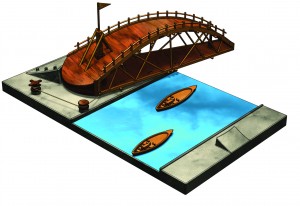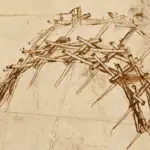Leonardo da Vinci swing bridge showcases his brilliance in blending art and engineering.
This unique invention was designed to pivot, allowing bridges to be retracted to prevent enemy crossings while also enabling friendly passage.
By exploring da Vinci’s ingenuity, you can appreciate how his designs for a movable bridge addressed both functional and strategic needs at the time.
The da Vinci swing bridge represents a fascinating example of innovation for those intrigued by historical engineering marvels.
This bridge used a series of winches and wheels, showcasing the advanced thinking that da Vinci applied to solving practical problems. Da Vinci’s Revolving Bridge further illustrates his contributions to military strategies by enabling quick and effective transport over water obstacles.
Through this exploration, one gains insight into da Vinci’s versatility. His ability to design for civilian and military purposes highlights his invaluable contributions to civil engineering.
The swing bridge is just one example of how his mechanical ideas inspire innovation today.
Overview of the Leonardo da Vinci Swing Bridge
Leonardo da Vinci designed the swing bridge to combine practicality and innovation.
It served civilian and military purposes, providing quick and strategic access across waterways while keeping enemies at bay. Key aspects include its functional use and historical significance in engineering.
The Concept Behind the Swing Bridge
The Leonardo da Vinci swing bridge was crafted with versatility in mind.
Intended for tactical advantages, it allowed travelers and soldiers to cross rivers swiftly.
What made it distinct was its ability to swing open and retract to prevent enemy access. This design showcased da Vinci’s brilliance in engineering, blending simplicity with strategic depth.
The structure used wooden beams interlocked to provide strength and flexibility. This engineering feat reflected da Vinci’s understanding of physics and mechanics, allowing the bridge to support significant weight yet remain operationally efficient.
Such concepts demonstrated how innovative approaches in design could solve practical problems of the time.
Historical Context of Leonardo da Vinci’s Designs
During Leonardo’s era, the need for movable bridges was essential, particularly in times of conflict.
The Leonardo da Vinci bridge was developed under the patronage of powerful leaders like Cesare Borgia, who sought effective solutions for military campaigns.
Da Vinci’s designs were not just architectural marvels but also tools of war.
His bridges, including the swing and revolving bridge, pioneered their time and laid the groundwork for modern movable bridges.
Through these designs, da Vinci provided insights into how to build a Leonardo da Vinci bridge using practical yet advanced techniques that have inspired engineers for generations.
How the Leonardo da Vinci Swing Bridge Works

Modern use of a swing bridge
The Leonardo da Vinci swing bridge represents an ingenious feat of engineering. Its design allows for practical use and strategic defense, providing insights into da Vinci’s brilliance.
Mechanics of the Swing Bridge Design
The swing bridge is a masterpiece of engineering. Its central pivot allows it to turn 360 degrees.
This pivot is fixed on one bank, enabling the bridge to rotate quickly. Ropes and pulleys complement this mechanism, assisting in moving the bridge smoothly.
Despite its size, a single person could maneuver the swinging bridge, illustrating da Vinci’s clever use of force distribution.
Crafted to be functional and defensive, the bridge was initially designed for military purposes.
It could span rivers or trenches and then be swung aside to prevent enemy crossings. This design’s simplicity and adaptability highlight da Vinci’s innovative approach to construction in the 15th century.
Advantages of the Swing Mechanism
The swing mechanism provided several advantages.
First, it offered rapid deployment and retraction, making it ideal for military operations. Soldiers could cross and secure strategic points quickly without needing a permanent bridge.
Additionally, the revolving nature of the da Vinci bridge allowed it to be moved to prevent enemy access.
This strategic advantage meant that it functioned not only as a passage but also as a deterrent.
The design also reflects da Vinci’s broader philosophy of harmonizing design with natural forces.
The way forces interlocked and provided stability showcases his understanding of engineering principles.
This combination of practicality and innovation makes the Leonardo da Vinci swing bridge a standout in engineering history.
Applications of the Leonardo da Vinci Swing Bridge
The Leonardo da Vinci Swing Bridge, a marvel of engineering, was not just a concept but a practical solution for various scenarios.
It combined innovation and functionality, allowing for military and civilian applications throughout history.
Historical Uses in Warfare
Leonardo da Vinci designed the swing bridge with military purposes in mind.
Mobility was crucial for armies during his time, especially when crossing rivers or canals. The revolving bridge enabled troops to move swiftly across bodies of water, facilitating strategic troop deployments and retreats.
The da Vinci Bridge could rotate 90 degrees, using a system of winches and wheels, to allow or block boats’ passage.
This function made it a defensive asset, providing a tactical advantage by controlling access to certain areas.
Modern Interpretations and Uses
Today, the Leonardo da Vinci Swing Bridge concept has inspired modern engineering projects.
Its design principles are used in educational settings to demonstrate the ingenious application of levers and balance. The self-supporting bridge exemplifies how ancient techniques can influence modern architecture and mechanical design.
Contemporary designers have adapted these principles to create structures requiring quick assembly or temporary setups.
This bridge’s ability to facilitate smooth water traffic control has been mirrored in several current canal and river management projects.
The da Vinci Swing Bridge remains a testament to Leonardo da Vinci’s forward-thinking approach and its lasting relevance in modern engineering.
Closing Remarks
Leonardo da Vinci’s swing bridge is a testament to his innovative spirit and mastery of engineering.
Designed for functionality, the bridge could swing open to allow ships to pass, showcasing its practicality during his time.
His design demonstrates a blend of creativity and functionality. The swing bridge concept involved rotating the bridge to make way for boats, highlighting da Vinci’s forward-thinking approach.
The simplicity and efficiency in da Vinci’s design continue to capture interest.
This bridge wasn’t just about mechanics but an example of harmonious design and utility working together.
Leonardo’s contributions go beyond art; his work, like the swing bridge, underscores his broad impact in engineering and design.
Key Takeaways: Leonardo da Vinci’s swing bridge illustrates an incredible fusion of creativity and practicality, inspiring future innovators.
Frequently Asked Questions
Leonardo da Vinci designed several innovative bridges, including the swing bridge. This section addresses common questions about his groundbreaking designs.
Who invented the swing bridge?
Leonardo da Vinci invented the swing bridge, which was part of his innovative approach to bridge design. It allowed passage over rivers while also acting as a defensive mechanism.
What is special about the da Vinci Bridge?
The da Vinci bridge is renowned for its ingenious design and structural capabilities, such as its self-supporting features without fasteners.
How did da Vinci’s revolving bridge work?
Da Vinci’s revolving bridge was designed for military use. It allowed soldiers to cross rivers quickly and could be easily moved to deter enemies.
Where can you find a real-life da Vinci bridge?
Real-life replicas of the da Vinci Bridge can be found in various locations. A notable one spans a canal near Oslo, Norway.
Who invented the Da Vinci bridge?
Leonardo da Vinci conceptualized the Da Vinci Bridge, and his designs have inspired the construction of numerous modern versions.
What is the purpose of the swing bridge?
The purpose of the swing bridge was to enable friendly passage over water and to retract back as a defensive barrier against opponents.
Why is it called the Swinging Bridge?
The Swinging Bridge is called because it can pivot or swing around a central point. This allows it to open for water traffic and close for foot traffic.
Where is the longest swinging bridge in the world?
The longest swinging bridge in the world is the Gatlinburg SkyBridge in Tennessee, USA. While not a da Vinci design, it holds the record for length.
What are the advantages of a swing bridge?
A swing bridge can easily open and close to allow ships to pass.
It combines both functionality and innovation, embodying da Vinci’s forward-thinking designs.
When was the last time the Swing Bridge opened?
Information about the last operation of a specific da Vinci swing bridge is not well-documented.
However, many modern swing bridges inspired by da Vinci’s ideas are still functional.




 Leonardo Bianchi,
the creator of Leonardo da Vinci's Inventions.
Thank you for visiting
Leonardo Bianchi,
the creator of Leonardo da Vinci's Inventions.
Thank you for visiting